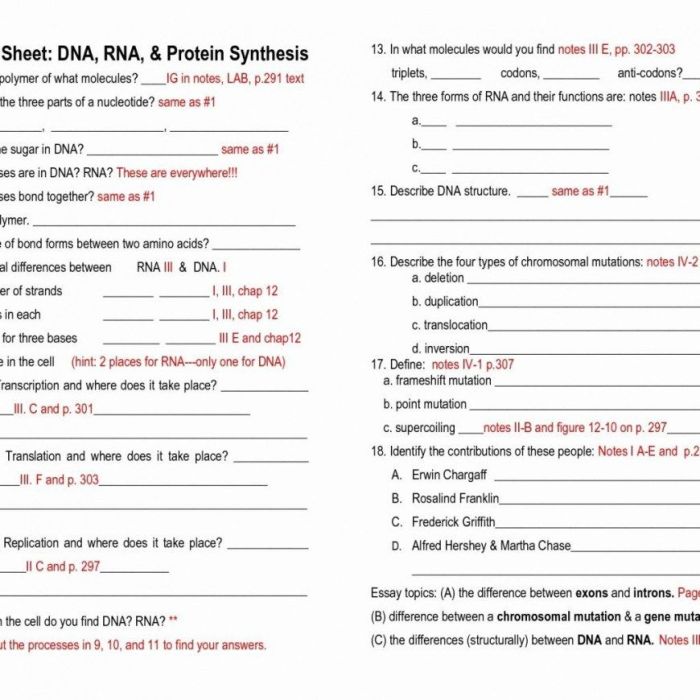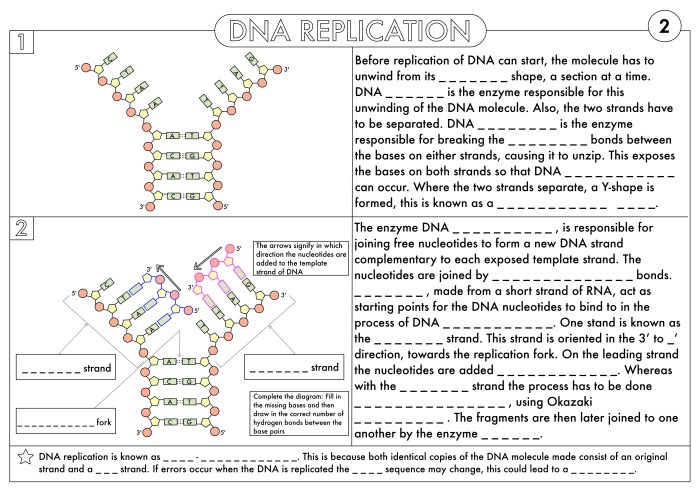From dna to protein worksheet – From DNA to Protein: Unraveling the Blueprint of Life embarks on an enthralling journey through the molecular mechanisms that govern the very essence of life. This comprehensive guide delves into the intricate processes that transform genetic information encoded within DNA into the functional proteins that drive cellular processes.
As we delve into the complexities of DNA structure and function, we will explore the role of transcription in converting DNA into RNA and the subsequent translation of RNA into proteins. Along the way, we will uncover the genetic code, the key to understanding how proteins are synthesized.
DNA Structure and Function
DNA, or deoxyribonucleic acid, is the molecule that carries genetic information in all living organisms. It is a double helix structure made up of nucleotides, which are composed of a sugar molecule, a phosphate group, and a nitrogenous base. The nitrogenous bases are adenine (A), thymine (T), guanine (G), and cytosine (C).
A always pairs with T, and G always pairs with C, forming base pairs that are held together by hydrogen bonds.
DNA stores genetic information in the sequence of its base pairs. This information is used to direct the synthesis of proteins, which are the building blocks of cells. DNA is also responsible for transmitting genetic information from one generation to the next.
Chromosomes
Chromosomes are structures in cells that contain DNA. Each chromosome consists of a single, long DNA molecule that is tightly coiled around proteins called histones. Chromosomes are essential for cell division, as they ensure that each daughter cell receives a complete copy of the genetic information.
The journey from DNA to protein is fascinating, but if you’re wondering about the effectiveness of hand sanitizer against STDs, check out this article . Returning to our topic, understanding this process is crucial for deciphering the genetic code.
Transcription: From DNA to RNA
Transcription is the process of converting the genetic information stored in DNA into a messenger molecule called RNA. This process takes place in the nucleus of eukaryotic cells and the cytoplasm of prokaryotic cells. The RNA molecule then carries the genetic information to the ribosomes, where it is used to synthesize proteins.
Key Players in Transcription
The key players involved in transcription are:
- RNA polymerase: An enzyme that synthesizes RNA molecules.
- Promoters: Regions of DNA that bind RNA polymerase and initiate transcription.
- Terminators: Regions of DNA that signal the end of transcription.
Differences Between DNA and RNA
DNA and RNA are both nucleic acids, but they have some key differences:
- Structure: DNA is a double-stranded molecule, while RNA is a single-stranded molecule.
- Bases: DNA contains the bases adenine, cytosine, guanine, and thymine, while RNA contains the bases adenine, cytosine, guanine, and uracil.
- Function: DNA stores genetic information, while RNA carries genetic information to the ribosomes.
Translation: From RNA to Protein

Translation is the process by which the genetic information encoded in mRNA is used to synthesize proteins. It takes place in the cytoplasm and involves three key players: ribosomes, tRNA, and mRNA.
Ribosomes
Ribosomes are large, complex structures composed of RNA and proteins. They serve as the site of protein synthesis, where mRNA and tRNA molecules interact to decode the genetic code.
tRNA (Transfer RNA)
tRNA molecules are small RNA molecules that carry amino acids to the ribosome. Each tRNA molecule has an anticodon, which is a sequence of three nucleotides that pairs with a complementary codon on the mRNA.
mRNA (Messenger RNA)
mRNA molecules carry the genetic code from the nucleus to the ribosome. They contain a series of codons, which are three-nucleotide sequences that specify which amino acid should be added to the growing protein chain.
The Genetic Code
The genetic code is a set of rules that determines how the sequence of codons in mRNA is translated into a sequence of amino acids in a protein. Each codon corresponds to a specific amino acid, with some codons specifying the start and stop signals for protein synthesis.
During translation, the ribosome moves along the mRNA molecule, reading the codons and aligning them with the corresponding anticodons on tRNA molecules. The amino acids carried by the tRNA molecules are then linked together to form a polypeptide chain, which eventually folds into a functional protein.
Protein Structure and Function

Proteins are essential molecules that play a diverse range of roles in biological systems. They are composed of amino acids linked together by peptide bonds. The structure of a protein is crucial to its function, and it can be described at four distinct levels.
Primary Structure
The primary structure of a protein refers to the linear sequence of amino acids. It is determined by the genetic code and defines the identity and order of the amino acids within the protein.
Secondary Structure
The secondary structure of a protein involves the formation of regular, repeating patterns along the polypeptide chain. These patterns include alpha-helices and beta-sheets, which are stabilized by hydrogen bonds.
Tertiary Structure, From dna to protein worksheet
The tertiary structure of a protein is the three-dimensional arrangement of the polypeptide chain. It is determined by the interactions between the amino acid side chains and can involve various types of bonds, including hydrogen bonds, hydrophobic interactions, and disulfide bonds.
Quaternary Structure
The quaternary structure of a protein refers to the arrangement of multiple polypeptide chains into a single functional unit. It is common in large proteins and involves interactions between the individual subunits.
The relationship between protein structure and function is intricate. The specific arrangement of amino acids in the primary structure determines the protein’s secondary and tertiary structures, which in turn dictate its quaternary structure. Ultimately, the overall structure of a protein governs its ability to interact with other molecules and perform its biological functions.
Proteins perform a vast array of functions within cells, including:
- Enzymes: Catalyze biochemical reactions.
- Hormones: Regulate various physiological processes.
- Antibodies: Protect the body from pathogens.
- Structural proteins: Provide support and shape to cells and tissues.
- Transport proteins: Facilitate the movement of molecules across membranes.
Mutations and Genetic Disorders
Mutations are permanent changes in the DNA sequence. They can be caused by various factors, such as errors during DNA replication, exposure to radiation or chemicals, and viral infections.
Mutations can have different effects on gene function. Some mutations are silent and do not affect the protein produced by the gene. Others may alter the protein’s structure or function, which can lead to genetic disorders.
Types of Mutations
- Point mutations: These involve changes in a single nucleotide base pair. They can be classified as:
- Substitution: One nucleotide is replaced by another.
- Insertion: A nucleotide is added to the sequence.
- Deletion: A nucleotide is removed from the sequence.
- Frameshift mutations: These occur when a nucleotide is inserted or deleted, causing a shift in the reading frame of the gene. This can lead to a completely different protein being produced.
Consequences of Mutations
The consequences of mutations can vary depending on the type and location of the mutation. Some mutations may have no effect, while others can lead to genetic disorders. Genetic disorders are conditions caused by mutations in specific genes.
Examples of Genetic Disorders
- Sickle cell anemia: This is caused by a point mutation in the gene that codes for the beta-globin protein in red blood cells. The mutated protein causes the red blood cells to become sickle-shaped, which can lead to anemia, pain, and organ damage.
- Cystic fibrosis: This is caused by a mutation in the gene that codes for the cystic fibrosis transmembrane conductance regulator (CFTR) protein. The mutated protein does not function properly, leading to a buildup of mucus in the lungs and other organs, which can cause respiratory problems, digestive problems, and other complications.
- Huntington’s disease: This is caused by a mutation in the gene that codes for the huntingtin protein. The mutated protein forms clumps in the brain, which leads to progressive degeneration of nerve cells and eventually death.
Applications of DNA Analysis

DNA analysis techniques have revolutionized various fields, including medicine, forensics, and evolutionary biology. By analyzing the genetic code, scientists can gain valuable insights into human health, disease, and the history of life on Earth.
One of the most significant applications of DNA analysis is in the field of medicine. By identifying genetic variations associated with diseases, researchers can develop more personalized treatments and preventive measures. For example, DNA sequencing can identify individuals at risk for certain cancers or genetic disorders, allowing for early detection and intervention.
Forensic Applications
- DNA fingerprinting is a technique used to identify individuals based on their unique genetic profile. This technology has revolutionized forensic science, enabling the identification of suspects and victims in criminal investigations, as well as the exoneration of the innocent.
- DNA analysis can also be used to determine paternity or maternity, resolving family disputes and establishing legal relationships.
Evolutionary Applications
- By comparing DNA sequences from different species, scientists can trace evolutionary relationships and reconstruct the history of life on Earth. This analysis has shed light on the common ancestry of all living organisms and the processes that have shaped the diversity of life.
- DNA analysis has also been used to study the evolution of humans, providing insights into our origins, migrations, and genetic diversity.
Q&A: From Dna To Protein Worksheet
What is the role of DNA in the cell?
DNA serves as the genetic blueprint, storing and transmitting genetic information essential for cellular function and inheritance.
How does transcription differ from translation?
Transcription converts DNA into RNA, while translation converts RNA into proteins.
What is the genetic code?
The genetic code is a set of rules that determines how the sequence of nucleotides in DNA or RNA is translated into the sequence of amino acids in a protein.